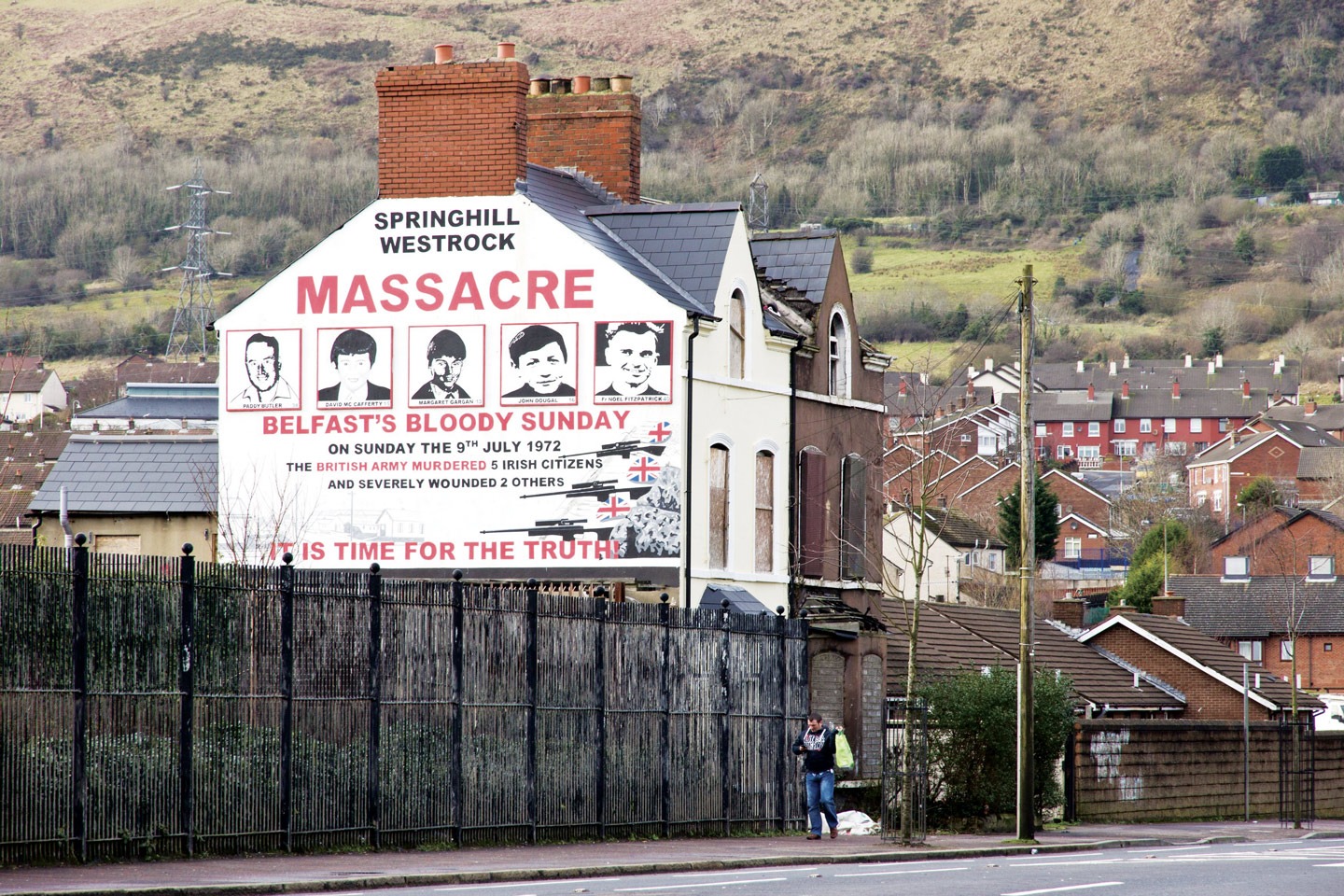Celebrating 25 Years of Peace in Northern Ireland, and the Quiet Canadian Who Got the Guns

For the last 30 years of the last century, the guerrilla war waged by the Irish Republican Army against British rule in Northern Ireland and by loyalist paramilitaries against the IRA besieged life in Ulster, defining it to the rest of the world as hopelessly cursed by conflict. Policy Associate Editor Lisa Van Dusen, who has covered the story as an editor and a columnist, describes how the curse effectively ended, with the help of Canadian General John de Chastelain.
Lisa Van Dusen
When we think of peace, especially in the context of negotiated peace agreements, silence is the most obvious evocation of the word. After all, if the cessation of hostilities means anything, surely it means an absence of gunfire, explosions, screaming, wailing sirens and all the other audible evidence of war. “When the battle’s lost and won,” per Macbeth’s Second Witch, “the hurly-burly’s done.”
But even before a technological revolution replaced so much of the noise of conventional weaponry with the less kinetic noise of propaganda, performative and not, as the preferred means of geopolitical and political domination-seeking (the illegal invasion of Ukraine being the most prominent recent exception to that trend), peace was about more than the revival of birdsong and the welcome change of a cortisol-free commute, especially in multi-generational conflicts.
It’s a lot harder for people to argue that peaceful coexistence is impossible when they’ve been drinking from the same coffee urn for months.
Over decades of fighting in Northern Ireland, as in the Middle East, an entire culture was built that saw hatred commodified as a weapon and civility marginalized as an existential threat. Leaders — political, paramilitary and criminal — built careers and livelihoods within these cultures based on the articles of faith that dialogue is weakness, intractability is power, compromise is a conflict of interest and negotiation an unforced error. Families were broken, prisoners taken, barriers of barbed wire, concrete and invisible firewalls erected; lives were ravaged and lost to the cause. And little by little, time solidified the intractability by providing too many players with a vested interest in preserving a corrupt and brutal status quo whose protection sustained their power.
In Northern Ireland, that cultural anthropology of conflict became well entrenched over the three decades of The Troubles — the war between Catholic republican and Protestant loyalist paramilitary groups that cost more than 3,600 lives.
Which is why April 10th, 1998 — the Good Friday on which an agreement was signed to end the violence by replacing it with a new culture of non-violent political power — was such a spectacular moment. And why President Joe Biden opened his homecoming visit to Ireland in April with a stop in Belfast to mark the 25th anniversary of the Good Friday Agreement.
On that Good Friday 25 years ago, amid the live, emotional coverage of the announcement of a major diplomatic breakthrough in what had been the world’s most intractable conflict (the Israeli-Palestinian stalemate now has sole ownership of the title) were the three men responsible for negotiating the agreement: US Senator George Mitchell, former Finnish Prime Minister Harri Holkeri and Canada’s former Ambassador to the United States, General John de Chastelain.

The moment marked the culmination of more than two years of negotiations that included the British and Irish governments of Tony Blair and Bertie Ahern and the Northern Ireland belligerents — republican and loyalist, nationalist and unionist — including the political and paramilitary acronym stew of: the Ulster Unionist Party (UUP, led by David Trimble); the Progressive Unionist Party (PUP, linked with the Ulster Volunteer Force or UVF paramilitary group); the Ulster Democratic Party (the political wing of the Ulster Defence Association or UDA paramilitary); the Social Democratic and Labour Party (SDLP, led by John Hume); and Sinn Féin (led by Gerry Adams), the political party associated with the Provisional Irish Republican Army (IRA). Labour unions were also represented, as well as the fed-up mothers, sisters and daughters of the Northern Ireland Women’s Coalition. The Catholic Hume and Protestant Trimble were awarded the Nobel Peace Prize in 1998 for their contribution to the process — a minimalist, deceptively binary approach by Oslo that, controversially but fittingly, represented the path of least resistance.
The Democratic Unionist Party (DUP), led by the famously bombastic Protestant/loyalist Ian Paisley, had earlier pulled out of the negotiations, with Paisley that April labelling the Good Friday Agreement “the mother of all treacheries” and calling Queen Elizabeth Tony Blair’s “parrot” for supporting it. In yet another Ulster miracle, Paisley evolved on the fundamentals over the following decade to the point of serving with Sinn Féin’s Martin McGuinness, a former IRA commander, in the Stormont power-sharing roles of joint first ministers in a dynamic so broey they were dubbed the “Chuckle Brothers” by media wags. It was a once-unimaginable conversion that makes the DUP’s current boycott of the Stormont assembly, yet another crisis attributable to Brexit, seem churlish.
What Mitchell, de Chastelain and Holkeri did as co-chairs of the talks stands today as a tribute to not just the massive task of mediating long-irreconcilable, inextricably enmeshed issues — from political power-sharing to the reconstitution of the Royal Ulster Constabulary (RUC) to the status of political prisoners — but to the value of diplomacy as an art; one based on the possibilities of what can happen when enemies are compelled to listen to each other within a civilizing ecosystem of daily routine, face-to-face conversation and casual observation in lieu of manufactured isolation and objectifying violence. It’s a lot harder for people to argue that peaceful coexistence is impossible when they’ve been drinking from the same coffee urn for months.
It’s also harder to demonize each other when the culture of conflict is finally decoupled from identity. “I’ve been all over the world, and I’ve never been any place where there are better people, more warm, more hospitable, more generous, more open than here in Northern Ireland,” Mitchell pointedly said during the news conference announcing the deal of a people and place that had become synonymous with trouble. “This is a remarkable place, with remarkable people.”
Yet on that day 25 years ago, John de Chastelain’s most serious work in Belfast was just beginning. As chair of the Independent International Commission on Decommissioning (Irish humour), de Chastelain would spend the next seven years of a planned two-year decommissioning deadline painstakingly, meticulously disarming (a word diplomatically avoided) the IRA. Per the aforementioned tenacity of entrenched cultures of conflict, the potent attachment to violence as a source of political leverage and the broader truth articulated by honorary Irishman Frederick Douglass that power never concedes without a demand, the IRA proved to be just about as attached to its arsenal as the punters broadly bet it would be at the time.
Interviewing de Chastelain from UPI in Washington and AP in New York in those days, when he was essentially living in Belfast’s Hotel Europa — known during The Troubles as “the most bombed hotel in the world” — was an education in the murky diplomacy of negotiating with the hard men of the IRA via a system of intermediaries, signals and codes so arcane and baroque it made John Le Carré look like The Secret Seven. On more than one occasion, De Chastelain’s background descriptions of the cloak-and-dagger contact camouflage prompted me to ask, “Are you sure?”, i.e. are you sure they’re not just taking the piss, to use an Irish term of art. “As sure as we can possibly be.”
On more than one occasion, de Chastelain’s background descriptions of the cloak-and-dagger contact camouflage prompted me to ask, ‘Are you sure?’, i.e. are you sure they’re not just taking the piss, to use an Irish term of art. ‘As sure as we can possibly be.’
After more than one political crisis produced by IRA stalling, when de Chastelain’s final report landed in 2005, the decommissioned arsenal included, per Jane’s Intelligence Review: 1,000 rifles, 3 tonnes of Semtex, 20–30 heavy machine guns, 7 surface-to-air missiles, 7 flame throwers, 1,200 detonators, 20 rocket-propelled grenade launchers, 100 handguns, and more than 100 grenades. On the loyalist side, the UVF formally decommissioned their weapons in June 2009, the UDA in January 2010. “Through all the twists and turns of the decommissioning process,” per The Guardian in 2003, “General John de Chastelain, the former head of the Canadian armed forces, has kept a low profile — and his patience.”
Over the years, there have been re-launches of the IRA brand of varying degrees of opportunism and authenticity, from the Real IRA formed to sabotage the Good Friday process (responsible for the terrible Omagh bombing of August 1998) to its successor, today’s New IRA, who’d reportedly planned a bombing — thwarted by police — to coincide with Biden’s visit this week. But for a quarter century, the social, economic and political benefits of the Good Friday Agreement have been felt by the people of Northern Ireland, who know that peace isn’t defined by silence; it’s defined by the freedom to be who and what you are absent the violations, distortions and disruptions of war. Anyone trying to turn back time to The Troubles now would have to fight a freedom-forged public backlash.
In his Booker-nominated 2013 novel TransAtlantic, Colum McCann fictionalizes three historic journeys: the first transatlantic flight — by Jack Alcock and Arthur Brown from St. John’s to Galway in 1919; Douglass’s time in Ireland in 1845-46; and George Mitchell’s shuttling to Belfast for the final leg of the negotiations that produced the Good Friday Agreement. “There are times he wishes he could knock an absolute simplicity into the process,” McCann writes of Mitchell. “Take it or leave it.”
William Butler Yeats, in Easter, 1916, immortalized the turning point of the failed Easter Rising with the refrain, “A terrible beauty is born”. No story truthfully described by such words was ever simple, and Mitchell surely knew that. “The true art of peace, negotiators know, lies in our ability to deal with the mighty weapon of language,” McCann also wrote, in the New York Times on the 15th anniversary of the “Easter miracle”, a decade ago. “Mr. Mitchell’s great dignity was that he knew the process belonged to others. Hundreds, or rather thousands, of people were responsible for peace. Mothers. Grandfathers. Philanthropists. Poets. Politicians. Even the gunmen.”
The chapter about the quiet Canadian who prevailed upon those gunmen — among the most redoubtable, determined, feared and fatefully romanticized characters in history — to give up their guns is somewhat lesser known, and also well worth celebrating. An epic story all around.
Policy Magazine Associate Editor and Deputy Publisher Lisa Van Dusen was a senior writer at Maclean’s, Washington columnist for the Ottawa Citizen and Sun Media, international writer for Peter Jennings at ABC News and an editor at AP National in New York and UPI in Washington. She also served as director of communications for the McGill Middle East Program in Civil Society and Peace Building.
